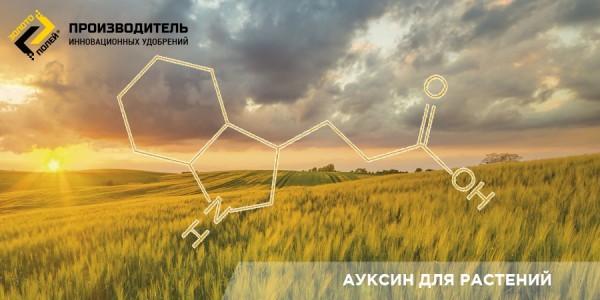Auxin is one of the most studied phytohormones of plant origin.
It is common to consider 4 types of auxin with the attached formulas (a, b and heteroauxin), but in fact the main one is only one – Beta-indolylacetic acid (BAI), and all the others are derivatives. That is, during the extraction, by means of PIU oxidation, there are different degrees of oxidation and, accordingly, different structures of the compound. The plant hormone auxin is an indole derivative, synthesized from tryptophan by three enzymes: transaminase, decarboxylase, aldehyde dehydrogenase.
Auxin is a kind of ‘great motivator’ for plants. After all, this phytohormone is already necessary for the germination of green sprouts. Most auxin is found in: shoot tips, root tips, and ovaries. Due to its transportability auxin has a significant effect on plants, moving to the growing and dividing cells, it affects the plant property and monitors their nutrition of the plant. Where a thickening of the SCI is detected, enhanced enrichment is directed. This action in auxin causes the upper bud to grow much faster. By giving light to the apical shoot, it inhibits the development of lateral shoots. As a result, the upper shoots are decapitated to redirect the phytohormone to the lateral leaves. Interestingly, in monocotyledonous plants, the coleoptile, not being a shoot but only a defense during germination, shows phototropism. Turns out they contain auxin, but only in an inactive form, a potential phyto stock.
In this way you get a closed circuit. The young, upper shoots send auxin down through the cambium thanks to photosynthesis, letting the root system know that growth is coming. And the root system, branching out with adventitious roots, forms auxin and sends it up signaling that everything is normal. Auxin acts as a plant growth regulator.
Auxins, while neither a fertilizer nor a plant protection agent, have a number of vital plant functions:
– Increased cell plasticity;
– Control of cell cycling;
– Regulation of the polarity of plant development;
– Control of directed growth actions;
– Assistance in the formation of lateral and adventitious roots;
– Assist in the development of lateral leaves;
– Crown architecture control
The mechanism of action of auxin is the phenomenon of ‘growth in an acidic environment’. Due to the acidic properties of the PIC, substances such as: polysaccharides, cellulose, hemicellulose, pectin, lose their rigidity. This facilitates the ingress of hydrogen ions, which causes the activation of proteins involved in cell growth. Due to this absorption of water, the cell expands in size.
Organochelate complex fertilizers as well as mono fertilizers (such as Mono Zinc) also play an important role in the regulation of auxin production and have several advantages:
– Increase the immunity of plants;
– Improve plant development;
– Increase Fertility;
– Increase the quality of the crop;
– Eliminate the possibility of the accumulation of harmful substances, etc.
Read more about complex and mono fertilizers in the articles: “Liquid Complex Fertilizers with Micronutrients”, “Organochelate Mono Fertilizers”, “Mono Zinc”, “Chelate Fertilizers”.
